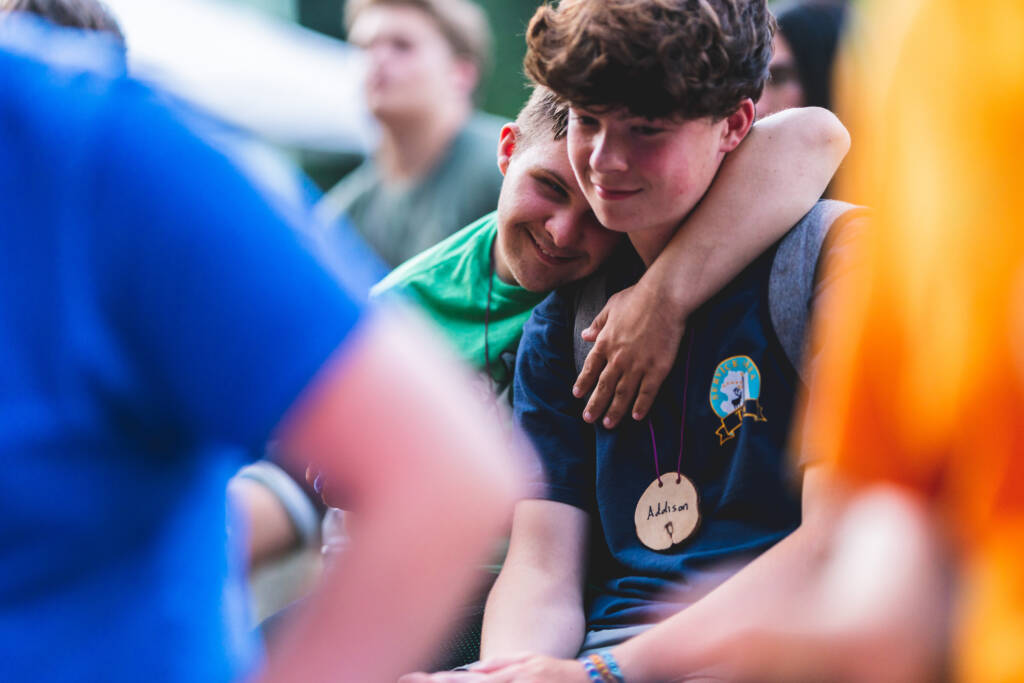Behavior
Behavioral Support Strategies
I come from the mountain
You come from the water
Go back to the fire
and turn your world around.
We come from the wind
Go back to the spirit
and turn your world around.
-Mt. Hood Kiwanis Camp song
Campers Who Exhibit Behaviors

Introduction
Many of our counselors and staff hear the word “behavior,” in relation to Camp, immediately think of physical behaviors. The truth is that for most of our campers, nothing could be farther from the truth. It is important to remember that behavior is a form of communication. For many of our campers they may lack the cognitive or communication skills to convey what they need using words. Some of them utilize behaviors as a way to get their point across. The word behavior can mean a multitude of things in a Camp setting. These actions are almost never out of anger but out of frustration because you haven’t been able to understand what they are conveying yet. It is also important for you to remember that it is not your job to be hit by a camper. You can back away from the camper, to provide space, and continue to engage with them, to decipher their needs. If a physical behavior persists, to the point that intervention is needed, our Oregon Intervention System (OIS) trained staff will step in to assist. As a counselor, you are NEVER to grab, hold, body block or restrain a camper. Camp is an amazing place, and our campers love to be there. They may just need a little support throughout the week.
Common Behaviors at Camp
- Sitting and refusing to go to the next activity or area (sitting strikes)
- Screaming or yelling
- Crying
- Running or walking away from the group
- Silence or pulling away from the group
- Physical touch or embrace for reassurance
- Refusal to eat, drink, or take medication
Why can campers sometimes display negative behaviors?
- Not being able to communicate.
- Lack of social recognition and praise.
- Over-abundance of vitality.
- Over-demanding program.
- Fear of entering a new experience.
- Not fully understanding what is expected.
- Learned behaviors prior to camp experience.
- Modeling others’ behavior.
- Seeking attention.
How to Avoid or React to Behaviors?
- Emotionally support the camper.
- Establish communication with the camper.
- Model appropriate Camp behavior.
- Remind them of upcoming/preferred activities in the schedule.
- Stay calm and collected.
- Bring them down to you; do not rise with them.
- Plan programs around increasing the responsibility of the camper.
- Avoid entering into power struggles with the camper.
- Consider presenting them with two options that are mutually acceptable outcomes (shares power).
- Express an interest in each camper.
- Give coaching in activities where the camper wishes to excel.
- Establish positive goals for each camper to work toward.
- Directors and/or Behavior Support may be called for help in some situations.
Behavior Support Strategies
Give the person choices or options:
Make sure that one of the choices is not a punishment.
- “You can choose to get in the canoe or you cannot have dessert at lunch”
Give the person choices that will bring about a desired behavior
- “Would you like to brush your teeth before you put pajamas on or would you like to brush your teeth after you put pajamas on?”
Use positive reinforcement:
Use specific and descriptive language – (not “good job”).
- “I really appreciate how quickly you picked up that mess, thank you.”
- “You were so gentle when you petted that horse; I’ll bet she really liked that.”
- “I noticed that you shared your paints with Tom. You two seemed to have fun.”
Use redirection:
Focus their attention on something that is positive and motivating for them, keeping their focus away from an aspect of the activity or task that is not so positive for them.
- Bobby hates changing activities – when it is time to change, you give him a special job or direction.
Ex: “Bobby, I need some help. I can’t carry this box by myself and I need to get it over to the canoes. Help me carry it over and I’ll owe you a big one.”
- Tom & Joe are beginning to argue. They both love to sing. You redirect away from the dispute and suggest that you all sing the new song that you learned last night.
Communicate with the person:
Talk with the person about the situation; ask them questions about how they feel, be honest with them, try to work out a solution together. Use their form of communicating whether it’s signing, speaking or using a picture system.
- Glenn (counselor) clears Terry’s lunch tray and prepares to go to the next activity. Terry suddenly screams at Glenn. When Glenn communicated with Terry, he found out that Terry had not finished lunch and was angry. Terry was taught a more appropriate way to express anger and Glenn always made sure to ask before clearing anyone’s tray.
Prevention:
- Set clear boundaries and expectations
- Give clear and specific directions; check for understanding or give one step at a time
- Know the person; know what motivates them, what frustrates them, etc…
- Let the person in on the “plan” or schedule
- PREPARE THE PERSON FOR TRANSITIONS!!!!!! Give them notices that transitions are coming.
- Anticipate what might be a problem or a trigger and make a plan, especially in program areas. Talk with your CS and/or ACS.
